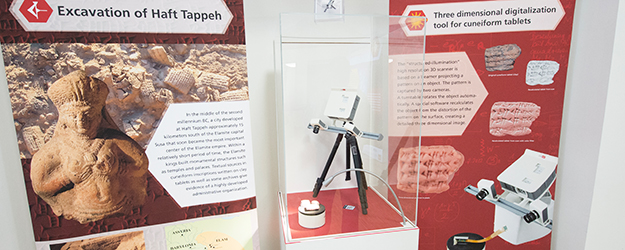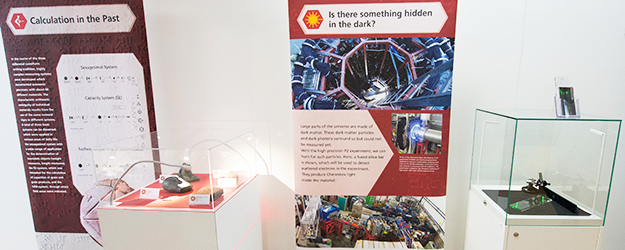1 July 2019
Doris Prechel, Professor of Ancient Near Eastern Philology at Johannes Gutenberg University Mainz (JGU), and Professor Frank Maas of the Helmholtz Institute Mainz (HIM) have teamed up to throw light on the past. With the help of state-of-the-art analytical devices developed for use in physics, they are busy deciphering thousand-year-old cuneiform tablets. The two researchers now presented the initial results of their cooperation in an exhibition.
"This is the beginning of a hopefully long-lasting cooperation," says Professor Doris Prechel. She and Professor Frank Maas are standing together in front of a display case that formed part of the exhibition, entitled Bringing the Past to Light. Inside can be seen what essentially brought the philologist and the nuclear physicist together – a digital 3D scanner on stilts, with its camera trained on a few unassuming pieces of tablet. On closer inspection, it becomes apparent that they are presumably fragments of a larger tablet, covered in tightly-packed cuneiform characters.
Maas explains how the scanner works: "We use a standard light projector to beam parallel lines onto an object. The light projection is then distorted by the object and two cameras record this distortion of the lines. The object rotates automatically, so it is scanned from a variety of angles. Computer software is used to record the dimensions, the structure and every detail. As a result, we obtain a precise digital image of the object."
This image can be used in many ways. "It’s possible to highlight the characters on the tablet, for example, which makes them much easier to recognize than on the original." A highly accurate analog replica can be produced simply using a 3D printer. Maas and his team have already done this in fact, as the tablets on display are actually replicas themselves, as the originals have been retained in Iran. In the future, the cuneiform characters could be matched with other characters, possibly using a pattern-recognition program. It might even be possible to use translation software as well. But before that, the next step will be to make the cuneiform study data available online.
An empire in Babylon's shadow
Prechel researches and teaches Ancient Near Eastern Philology at the Institute of Ancient Studies at JGU, while Maas is a professor at the Institute for Nuclear Physics at JGU. Both were founding directors of the Helmholtz Institute Mainz (HIM), in whose foyer they and their colleagues decided to stage the ‘Bringing the Past to Light’ exhibition. The exhibition served to show how science can illuminate the past in a wide variety of ways.
At the beginning of the year, Prechel and her team set off for Iran to visit the Haft Tappeh archaeological site. They took a 3D scanner along with them. "In the middle of the second millennium B.C., Haft Tappeh developed into one of the most important cities in the Elamite empire," she says. "It’s rather puzzling as to why this was. It is just a stone’s throw away from Susa, the Elamite capital. Why on Earth did they build a second important city so close by? What purpose did it serve?"
The Elamite empire was founded in around 3000 B.C., in the region known as the Fertile Crescent. It has been relatively overlooked in research terms, as Babylon, Sumeria and Akkad have attracted greater interest. "It’s completely wrong to have had this Babylon-centric view," criticizes Prechel, who is now contributing to a long-overdue correction of this.
Researchers from Mainz started working in Haft Tappeh in 2004. Since then, hundreds of cuneiform tablets have been uncovered. A photograph of them was part of the exhibition at HIM. "These pieces of clay can crumble at the slightest touch, especially if they have not been baked," explains Prechel. "With the 3D device we were able to scan these fragments as well, without having to touch them." Maas had previously instructed her on how to operate the scanner and she managed to collect a digital inventory of around 500 tablets in just a month.
A calculation system that survived for millennia
Cuneiform script, along with Egyptian hieroglyphics, is one of mankind’s earliest known writing systems. It was used by several cultures over the next few thousand years. "So far, any attempts to decipher this writing have been based on a limited body of text. Ours is now the first large-scale project to deal with these particular Elamite texts."
Through the exhibition, Maas and Prechel were not only profiling their cooperation in the field of cuneiform, but were also exploring the crossovers between their academic disciplines. Maas, whose subjects are quarks and gluons, points out: "I'm interested in the new physics beyond the Standard Model." Essentially, this means the nature of the universe, how it was created in the Big Bang and what processes have been in play since then. From observations of light sources in the night sky, we know that the presence of 95 percent of the mass and energy in the universe is unexplained. In order to discover what constitutes this, Maas and his team generate cosmic matter in particle accelerators, and attempt to identify possible candidates that could make up the components of dark matter, for example.
"One of our constant problems is tacit criticism of our work - the question of whether our research can deliver specific benefits apart from a mere increase in understanding," Maas states. "Because of this collaboration we have been able to demonstrate that our devices also have practical applications that could help lead to further discoveries. For example, we could analyze pieces of the cuneiform tablets in the MAMI particle accelerator, or the TRIGA reactor on the JGU campus, and determine exactly where the clay came from that the writers used 3000 years ago."
Bringing the Past to Light also outlined how the cultures in the Babylonian world were already interested in the processes occurring in the cosmos. They not only created a writing system, but also a calculation system which then allowed them to define cosmic events, agricultural yields and even calculate the dimensions of a temple tower. "Their sexagesimal system used units of six and ten," says Prechel. "Just as we do in our research today," adds Maas. "We primarily use the decimal system, but at the same time we still divide things into minutes and hours."
The GRC as an exchange platform
Bringing the Past to Light was used to showcase reproductions of ancient Near Eastern artifacts alongside the state-of-the-art technology used by Maas and his team. "We have learned a lot from each other," Prechel remarks. "The same goes for our team members. We have had to try and communicate in a way that the other side understands, and that has brought even more clarity to our own research."
The philologist and the physicist appreciate the interdisciplinary exchange, which for them had already begun at the Gutenberg Research College (GRC) at JGU. The GRC brings together outstanding researchers at the university and the two are members of its executive committee. "It is a remarkable institution that not only advises the university on strategic issues," says Maas. "A much more important aspect is how it functions as a platform for interaction with others. Where else am I as a nuclear physicist going to meet a neurologist or a classical philologist?"
The discipline of Ancient Studies will increasingly adopt digital techniques and this will open up a whole range of new opportunities. Prechel is already in contact with the Computer Science department and mainzed, the Mainz Center for Digitality in the Humanities and Cultural Studies. In the meantime, Maas looks into the display cases at what the cuneiform script has to offer. He points to a tablet: "Believe it or not, this provides instructions on how to brew beer!" he says in amazement.
Bringing the Past to Light broke down barriers and provoked curiosity. The exhibition, though small, left a large impression. The Rhineland-Palatinate Science Minister Prof. Konrad Wolf was a visitor, while a recording team from the broadcaster SWR was also present. "This is just the start of what will be a major academic collaboration," affirms Maas.



